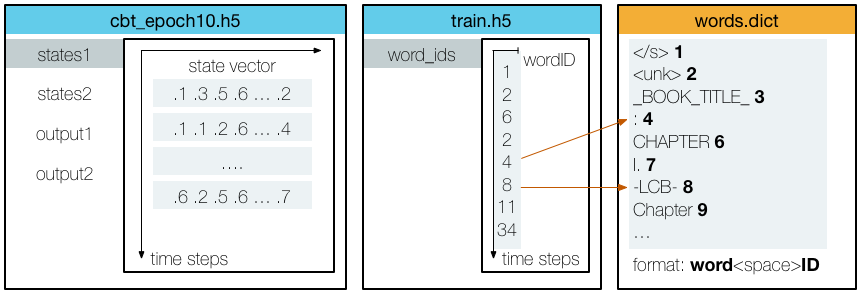More information about LSTMVis, an introduction video, and the link to the live demo can be found at lstm.seas.harvard.edu
Clone the repository:
git clone https://github.com/HendrikStrobelt/LSTMVis.git; cd LSTMVisInstall python (server-side) requirements using pip:
pip install -r requirements.txt
on OSX 10.11 (El Capitan):
pip install --user -r requirements.txtDownload & Unzip example dataset(s):
Children Book - Gutenberg - 2.2 GB
start server:
python server.py -dir <datadir>open browser at http://localhost:8888 - eh voila !
If you want to train your own data first, please read the Training document. If you have your own data at hand, adding it to LSTMVis is very easy. You only need three files:
- HDF5 file containing the state vectors for each time step (e.g.
cbt_epoch10.h5) - HDF5 file containing a word ID for each time step (e.g.
train.h5)* - Dict file containing the mapping from word ID to word (e.g.
words.dict)*
A schematic representation of the data:
*If you don't have these files yet, but a space-separated .txt file of your training data instead, check out our text conversion tool
LSTMVis parses all subdirectories of <datadir> for config files lstm.yml.
A typical <datadir> might look like this:
<datadir>
├── children_book <--- project directory
│ ├── lstm.yml <--- config file
│ ├── cbt_epoch10.h5 <--- states for each time step
│ ├── train.h5 <--- word ID for each time step
│ └── words.dict <--- mapping word ID -> word
├── fun ..
a simple example of an lstm.yml is:
name: children books # project name
description: children book texts from the Gutenberg project # little description
files: # assign files to reference name
states: cbt_epoch10.h5 # HDF5 files have to end with .h5 or .hdf5 !!!
train: train.h5 # word ids of training set
words: words.dict # dict files have to end with .dict !!
word_sequence: # defines the word sequence
file: train # HDF5 file
path: word_ids # path to table in HDF5
dict_file: words # dictionary to map IDs from HDF5 to words
states: # section to define which states of your model you want to look at
file: states # HDF5 files containing the state for each position
types: [
{type: state, layer: 1, path: states1}, # type={state, output}, layer=[1..x], path = HDF5 path
{type: state, layer: 2, path: states2},
{type: output, layer: 2, path: output2}
]
Check out our documents about:
- details about configuring the states file input
- adding annotation files for result heatmaps
- training a model with torch
- tools that make your life easier
LSTMVis is a collaborative project of Hendrik Strobelt, Sebastian Gehrmann, Bernd Huber, Hanspeter Pfister, and Alexander M. Rush at Harvard SEAS.


